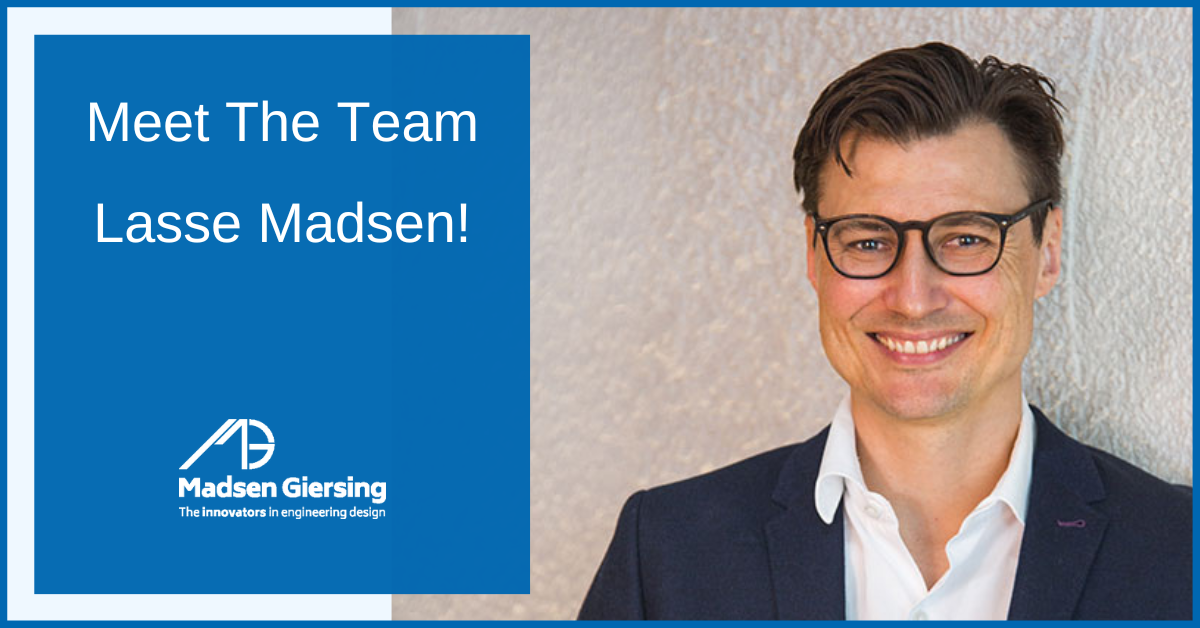
CEO of Madsen Giersing, Lasse Madsen, celebrated 19 years with the organisation recently, so we caught up with Lasse to learn more about his career to date, favourite projects and the inspirations behind his career in engineering.

Peter and Lasse at the start of Lasse’s career at Madsen Giersing.
Why did you become an engineer?
Like many engineers, I have been inspired by structures, bridges, buildings, and anything I saw growing up or travelling. I always enjoyed building, creating and designing my own feats of engineering with Lego, so when added to my family history of engineering, there was only ever going to be one way my career went.
What do you love about engineering?
I enjoy solving a difficult problem and working to find a solution. There is something satisfying about taking the time to get under the skin of a problem, take the challenge on and work out an efficient and safe design to create a solution.
What are you working on at the moment?
To support the expansion of IOR Petroleum’s Lytton Terminal to a multiple bulk fuel import, storage, and distribution terminal, I am designing a temporary crane support platform for 500T crawler crane.
I am also involved in the design of the temporary works to support the transformation of Sydney Fishmarket, a major redevelopment that will see a waterfront promenade, a ferry wharf and more than 6,000 square metres of new public open space created to support the iconic tourist attraction’s growth and future.
What has been your greatest professional achievement to date?
It has to be having the opportunity to work with my father, Peter, for the past 19 years. It has been fantastic to work with him, to learn from his experience and to be entrusted to take Madsen Giersing into the future as CEO and build on his legacy of three decades of achievement.
What’s the best project you have worked on?
Motukea Cargo Wharf for Curtain Brothers in Papua New Guinea. It is one of those complex projects that engineers love, with a number of challenges to overcome and some interesting design features. The berth is 210m long and accommodates vessels up to 60,000 DWT.
The top of the berth is at RL 4.5m and comprises a 1.6m wide concrete capping beam, and the berth pocket is at RL -13m. The berth is a gravity-type structure comprising cellular cofferdams, each with a diameter of 20m and constructed from flat sheet piles.
What would your last meal be?
Simplicity is the key for me, so I’d have to go with steak, chips and a salad.
What is the last movie you watched or series you binged?
Top Gun Maverick. Who doesn’t love a bit of high-octane nostalgia?
Who’s the greatest engineer of all time and why?
There are so many engineers to choose from that it’s hard to pick one. But structure I have always admired the Brooklyn Bridge in New York. Designed by John A Roebling, it is the perfect combination of function and form for me, as it combines some great engineering, looks spectacular and provided a vital connection between Brooklyn and Manhattan that shaped the future of New York.
What would be your dream project to work on from history?
Without a doubt, the Brooklyn Bridge. For the reasons above, but also because, at the time, it was a technological marvel with John A Roebling designing a machine that twisted steel wire into cable, making construction possible.
What piece of advice would you give to an aspiring engineer?
If you are not passionate and don’t like problem-solving, engineering is probably not for you!
What has been the biggest change in your 19 years at Madsen Giersing?
There have been several changes, but the standouts for me are how the industry is changing with technology and an industry-wide focus on health and safety, the environment and sustainability.
What is your favourite project across the 19 years, and why?
Our work with Curtain Brothers on their Motukea facility in Papua New Guinea. We have supported numerous aspects of the project in our long-term partnership and have delivered exceptional results. From a slipway designed to accept ships up to 10,000 DWT with a length of 110m and a maximum lightweight of 5,300t to a 210m export wharf which accommodates vessels up to 60,000 DWT, each stage of the facility’s development has been the perfect example of collaboration between client and consultant to design marine infrastructure to support a client’s need.
What has been the most challenging project you have supported, and why?
Hegigio Gorge Pipe Bridge. It was a technically challenging project in very tough geographical conditions and a remote location.
The bridge comprises three catenary cables, two horizontal and one vertical, joined together by a series of wire stays and cross beams. Two parallel runway beams connect the series of cross beams, allowing access along the bridge via a trolley. The main cable is connected to a 33m high A-frame tower at the southern abutment and a 4m high tower at the northern abutment.
Madsen Giersing designed various structures to provide access during construction, including two temporary platforms bolted to the top of the south tower and two 12-storey 9m x 3m access towers. The access towers were also designed to allow the south tower A-frame to be raised using a reeved system specifically designed for this purpose.
To launch the bridge, horizontal cables, cross and runway beams, and a restraint system was developed to allow the bridge to be launched in a safe and controlled manner. Several structures were designed to assist in forming, positioning and launching the horizontal cables, each comprised of 70 strands. These structures included a guide tower, cable reel and deflector towers.
Madsen Giersing designed two trolleys to install the oil pipelines; one to pull the pipelines across the bridge and the other to allow personnel access along the bridge to install pipe clamps at the cross beams.
As a project, it showcases everything we do well at Madsen Giersing.
What do you think will be the biggest change in engineering in the next 19 years?
It will be the continued roll-out and technology. From digital twins of structures to Artificial Intelligence testing concrete or steel health, technology will continue to play a greater role in engineering.


